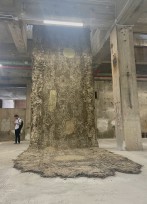

Yield 2024 roots, soil, gras, yellow fabric 14000 cm x 2500 cm


#2
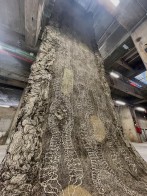

#3


#4
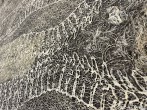

#5
Manifesta 15 Metropolitana September 8th 2024
https://www.manifesta15.org/organisation?category=5&page=events-slug&slug=yield
https://www.instagram.com/diana__scherer/p/C_nrY0Ho_DN/?img_index=1
Commissioned by Manifesta 15 Barcelona Metropolitana
Supported by Mondriaan Fund and the Embassy of the Kingdom of the Netherlands to Spain
Many thanks for all support Colin Huizing and Museum Kranenburgh


Hyper Rhizome # 7 2025 green mesh, grown root textile with patterns of car tracks and red cabbage. 400 cm x 250 cm


Hyper Rhizome # 11 2023 grown root textile on jute with patterns of microscopic plant structures and circles. 300 cm x 150 cm


#3


#4
Re – Constellations
Exhibition Director: Jinfei Ying
Artistic Director: Hui Shi
Co-Curator: Jun Jiang , Huang Yan , Assadour Markarov , Jia Xu
Assistant Curator: Junyu Li , Jiachen Liu , Zhe Ren , Chaowei Zeng
Participating Artists:
金守子(Kimsooja,韩国, 荒川医(Ei Arakawa,日本)易卜拉欣•马哈马(Ibrahim Mahama,加纳)朱利安·克鲁泽(Julien Creuzet,法国)(Aziza Kadyri,俄罗斯)赵素熙(Cho Sohee,韩国)崔真、夏因(Choi +Shine,美国)格尔加娜·塔巴科娃(Gergana Tabakova,保加利亚)卡里·迪尔达尔(Kari Dyrdal,挪威)阿齐扎•卡迪里(Aziza Kadyri,俄罗斯)凯特·伊根(Kate Egan,英国)莱昂纳多·奇亚奇奥 & 丹尼尔·贾诺内(Leonardo Chiachio & Daniel Giannone,阿根廷)莱昂纳多·乌利安(Leonardo Ulian,意大利)莱拉·卡德纳斯(Leyla Cárdenas,哥伦比亚)露西·奥尔塔 + 豪尔赫·奥尔塔(Lucy +Jorge Orta,英国)玛娜尔·阿尔多瓦扬(Manal AlDowayan,沙特阿拉伯)玛丽尔·克莱蒙特(Mariel Clarmont,法国)派翠西亚·伊斯塔柯(Patricia Perez Eustaquio,菲律宾)索尔维格·阿尔伯格(Solveig Aalberg,挪威)康瑞璟(Suki Seokyeong Kang,韩国)http://fiberarthangzhou.en.caa.edu.cn/2025/show_summary/zlgk/index.html


400 cm x 400 cm


800 cm x 300 cm


#3


#4


#5


#6


#7


600 cm x 400 cm


#9


#10


#11


#12


#13


600 cm x 450 cm
1 Oct 2023 – 8 April 2024
In this solo exhibition, Farming Textiles, Diana Scherer reflects on humankind’s capacity and constraints in influencing nature while also highlighting the contemporary detachment between humans and the natural world. Farming Textiles showcases many recent works and features an installation of textiles ‘in the making’, allowing visitors to follow its growth process.
Curator Colin Huizing
Avro Tros Kunst Nu te zien!:
https://npo.nl/start/serie/nu-te-zien/seizoen-8/nu-te-zien_49/afspelen
https://www.kranenburgh.nl/tentoonstelling/129/diana-scherer-farming-textiles


#1
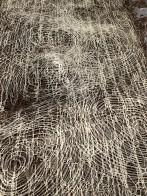

#2


#3
6. Biennale Reset Now! August 6 2023
Invited are 27 national and international contemporary artists who work at the interface of science, technology and art. Their works integrate complex themes and techniques such as AI, cybernetics, augmented reality and bio art. The exhibition “resetNOW!” presents itself as an experiment on aesthetics and technology. The aim is to show synergies and competences and to present a multifaceted picture of artistic discourse and production. In doing so, the relationship between science, art and society as well as the dissolution of boundaries will be addressed. The works of the artists invite the visitors to a parcours that condenses this theme kaleidoscopically.
Artists: Alexandra Bircken, Birthe Blauth, Tatjana Busch, Louisa Clement, Ursula Damm, Jana Debrodt, Nausikaa Hacker, Kelly Heaton, Alexandra Hendrikoff, Barbara Herold, Franka Hörnschemeyer, Notburga Karl, Brigitte Kowanz, Alicja Kwade, Julia Lohmann, Peggy Meinfelder, Anna Pasco Bolta, Nana Petzet, Anne Pfeifer, Sophia Pompéry, Rasha Ragab, Diana Scherer, Susanne Schütte-Steinig, Selma Selman, Catharina Szonn, Susanne Wiegner and Anne Wodtcke.
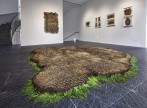

400 cm x 400 cm


#2


#3


#4


#5
The Intelligence of Plants
16.10.2021 — 30.01.2022
With the exhibition The Intelligence of Plants, the Frankfurter Kunstverein wants to once again contribute to the debate about the Anthropocene: what new understanding of plant life have we humans gained, and what conclusions can we draw from this knowledge. If plants were the first living beings on the planet, they have proven to have developed successful methods to sustain themselves over millions of years despite the five past occurrences of species extinction.
Curator Franzisca Nori
Artists: Berlinde de Bruyckere, Diana Scherer, Nicola Toffolini a.o.
https://www.fkv.de/en/exhibition/die-intelligenz-der-pflanzen/.


#1
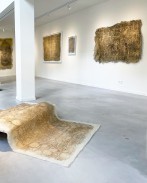

#2


#3


#4


#5


#6
Solo exhibition Wonderground
24 September 2022 -8 January 2023 Roof -A Rotterdam


400 cm x 400 cm


#2


#3
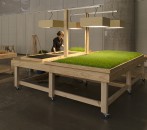

#4


#5


#6
https://www.biennaleofsydney.art/
Entanglement, 2022 soil, seed, grass roots, timber
Commissioned by the Biennale of Sydney with generous support from the Goethe-Institut Australia and with generous assistance from Mondriaan Fund and the Embassy of the Kingdom of the Netherlands in Australia
In a laboratory-like set up, visitors are invited to see Diana Scherer at work as she undertakes what she refers to as “collaborations with nature” growing networks of roots into unique patterns of woven textile. Known by neurobiologists as the brain of plants, Scherer draws attention to roots as active intelligent agents in the process of producing living fabrics.
Scherer is particularly fascinated by the hidden systems of plants. Her project Entanglement looks at xylem vessels, the tissue responsible for transportation of water through plants. Examining closely the interdependence of plants and water, the pattern Scherer creates with the roots is inspired by the forms of the xylem vessels in plant anatomy. The emergence of these water vessels in plants is considered one of the most important evolutions in the life of plants. Taking geometric and ordering principles and patterns from nature, Scherer poses a dilemma as her craft is both a manipulation of natural processes and possible cultivation of a joint path together.
“A root navigates, knows what is up and down, perceives gravity and can locate moisture and chemicals. Roots are incredibly strong. In their search for food and space they fight for every space they can find. I use this strength to create my work. I expose the subterranean life and natural network turns into a textile-like material. The dynamism of the plant makes it seem as if the work is making itself.
I have learned to deal with the autonomy of nature. Despite my intervention, the outcome is unpredictable every time. The interaction of control and letting go is an important element in my work.” – Diana Scherer
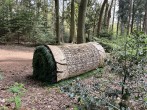

200 cm x 150 cm


#2


#3


#4


#5


#6
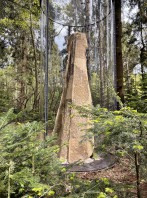

#7


#8
Harvest Recasted 2022
Curator Hans Den Hartog Jager
The exhibition consists of new work by Marianna Simnett, Charles Avery, Mercedes Azpilicueta, Diana Scherer, Erik van Lieshout, Augustas Serapinas, Isa van Lier, Jakob Kudsk Steensen, Kasper Bosmans, Renzo Martens / CATPC, Alexandra Pirici and Em’kal Eyongakpa.
Design and production vitrines: Shahin Emamgholizadeh
https://arcadia.frl/en/projecten/paradys/?cn-reloaded=1
Installation Harvest Recasted 2022
For the Triennial Paradys Arcadia in Oranjewoud 2022, Scherer grew three long dresses 300 cm high. The dresses refer to three noble women who each left their own mark on the history of the Oranjewoud estate. Like ghosts sprouting from the ground, the dresses rose up in their protective display cases: one for the estate’s founder Albertine Agnes van Nassau (1634-1694), one for her daughter-in-law Henriette Amalia van Anhalt-Dessau (1666-1726) and one for Maria Louise van Hessen-Kassel (1688-1765).
The three women act as characters through which Scherer made visible the different historical layers and characters of Oranjewoud. In the patterns Scherer used, themes appropriate to their roles can be recognised. The dresses were displayed in three round showcases in the middle of the Oranjewoud forest. She also placed three sculptural grass rolls with root patterns in the forest. The grass roll is a reference to the farmers who were driven out of here centuries ago to make way for Albertine Agnes’ estate. But the roll also refers to a roll of fabric, as sold by the yard, ready to be cut for a new dress.
